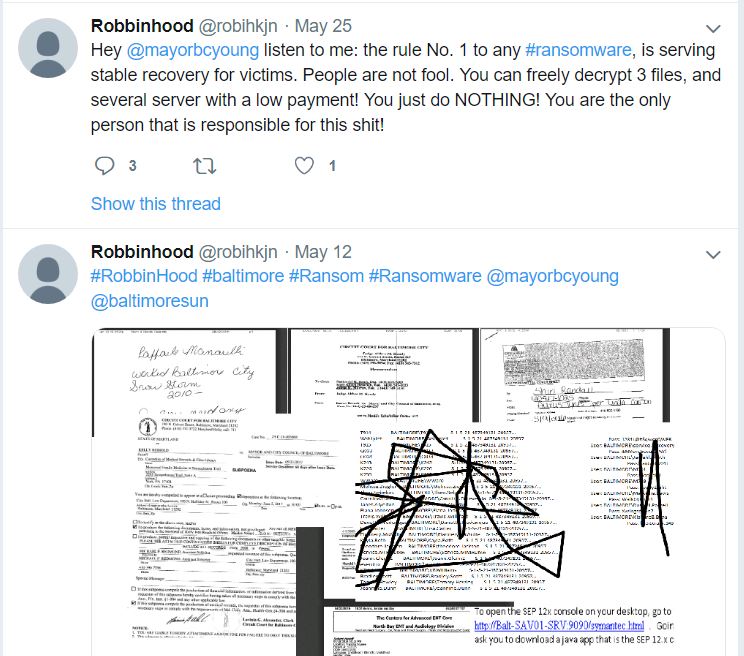The crooks behind an affiliate program that paid cybercriminals to install the destructive and wildly successful GandCrab ransomware strain announced on May 31, 2019 they were terminating the program after allegedly having earned more than $2 billion in extortion payouts from victims. What follows is a deep dive into who may be responsible for recruiting new members to help spread the contagion.

Image: Malwarebytes.
Like most ransomware strains, the GandCrab ransomware-as-a-service offering held files on infected systems hostage unless and until victims agreed to pay the demanded sum. But GandCrab far eclipsed the success of competing ransomware affiliate programs largely because its authors worked assiduously to update the malware so that it could evade antivirus and other security defenses.
In the 15-month span of the GandCrab affiliate enterprise beginning in January 2018, its curators shipped five major revisions to the code, each corresponding with sneaky new features and bug fixes aimed at thwarting the efforts of computer security firms to stymie the spread of the malware.
“In one year, people who worked with us have earned over US $2 billion,” read the farewell post by the eponymous GandCrab identity on the cybercrime forum Exploit[.]in, where the group recruited many of its distributors. “Our name became a generic term for ransomware in the underground. The average weekly income of the project was equal to US $2.5 million.”
The message continued:
“We ourselves have earned over US $150 million in one year. This money has been successfully cashed out and invested in various legal projects, both online and offline ones. It has been a pleasure to work with you. But, like we said, all things come to an end. We are getting a well-deserved retirement. We are a living proof that you can do evil and get off scot-free. We have proved that one can make a lifetime of money in one year. We have proved that you can become number one by general admission, not in your own conceit.”
Evil indeed, when one considers the damage inflicted on so many individuals and businesses hit by GandCrab — easily the most rapacious and predatory malware of 2018 and well into 2019.
The GandCrab identity on Exploit[.]in periodically posted updates about victim counts and ransom payouts. For example, in late July 2018, GandCrab crowed that a single affiliate of the ransomware rental service had infected 27,031 victims in the previous month alone, receiving about $125,000 in commissions.
The following month, GandCrab bragged that the program in July 2018 netted almost 425,000 victims and extorted more than one million dollars worth of cryptocurrencies, much of which went to affiliates who helped to spread the infections.
Russian security firm Kaspersky Lab estimated that by the time the program ceased operations, GandCrab accounted for up to half of the global ransomware market.
ONEIILK2
It remains unclear how many individuals were active in the core GandCrab malware development team. But KrebsOnSecurity located a number of clues that point to the real-life identity of a Russian man who appears to have been put in charge of recruiting new affiliates for the program.
In November 2018, a GandCrab affiliate posted a screenshot on the Exploit[.]in cybercrime forum of a private message between himself and a forum member known variously as “oneiilk2” and “oneillk2” that showed the latter was in charge of recruiting new members to the ransomware earnings program.
Oneiilk2 also was a successful GandCrab affiliate in his own right. In May 2018, he could be seen in multiple Exploit[.]in threads asking for urgent help obtaining access to hacked businesses in South Korea. These solicitations go on for several weeks that month — with Oneiilk2 saying he’s willing to pay top dollar for the requested resources. At the same time, Oneiilk2 can be seen on Exploit asking for help figuring out how to craft a convincing malware lure using the Korean alphabet.
Later in the month, Oneiilk2 says he no longer needs assistance on that request. Just a few weeks later, security firms began warning that attackers were staging a spam campaign to target South Korean businesses with version 4.3 of GandCrab. Continue reading








 Microsoft says it has so far seen no exploitation against any of the four flaws that were disclosed publicly prior to their patching this week — nor against any of the 88 bugs quashed in this month’s release. All four are privilege escalation flaws:
Microsoft says it has so far seen no exploitation against any of the four flaws that were disclosed publicly prior to their patching this week — nor against any of the 88 bugs quashed in this month’s release. All four are privilege escalation flaws:  Just a few days ago, the news was all about how Quest had suffered a major breach. But today’s disclosure by LabCorp. suggests we are nowhere near done hearing about other companies with millions of consumers victimized because of this incident: The AMCA is a New York company with a storied history of aggressively collecting debt for a broad range of businesses, including medical labs and hospitals, direct marketers, telecom companies, and state and local traffic/toll agencies.
Just a few days ago, the news was all about how Quest had suffered a major breach. But today’s disclosure by LabCorp. suggests we are nowhere near done hearing about other companies with millions of consumers victimized because of this incident: The AMCA is a New York company with a storied history of aggressively collecting debt for a broad range of businesses, including medical labs and hospitals, direct marketers, telecom companies, and state and local traffic/toll agencies.

